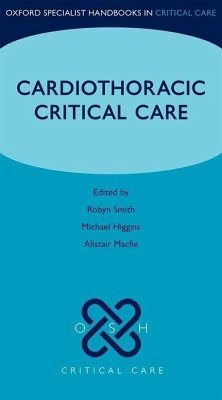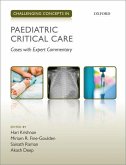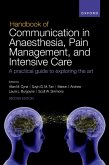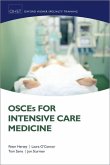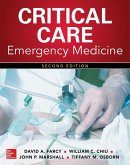Cardiothoracic Critical Care
Herausgeber: Smith, Robyn; Macfie, Alistair; Higgins, Michael
Cardiothoracic Critical Care
Herausgeber: Smith, Robyn; Macfie, Alistair; Higgins, Michael
- Broschiertes Buch
- Merkliste
- Auf die Merkliste
- Bewerten Bewerten
- Teilen
- Produkt teilen
- Produkterinnerung
- Produkterinnerung
This concise, practical Oxford Specialist Handbook provides an evidence-based approach to all aspects of patient care in cardiothoracic intensive care.
Andere Kunden interessierten sich auch für
![Challenging Concepts in Paediatric Critical Care Challenging Concepts in Paediatric Critical Care]() Challenging Concepts in Paediatric Critical Care92,99 €
Challenging Concepts in Paediatric Critical Care92,99 €![Oxford Handbook of Critical Care Nursing Oxford Handbook of Critical Care Nursing]() Fiona Creed (Senior Lecturer, Senior Lecturer, School of Nursing anOxford Handbook of Critical Care Nursing45,99 €
Fiona Creed (Senior Lecturer, Senior Lecturer, School of Nursing anOxford Handbook of Critical Care Nursing45,99 €![Acute and Critical Care Echocardiography Acute and Critical Care Echocardiography]() Acute and Critical Care Echocardiography102,99 €
Acute and Critical Care Echocardiography102,99 €![Care of the Acutely Ill Adult Care of the Acutely Ill Adult]() Care of the Acutely Ill Adult64,99 €
Care of the Acutely Ill Adult64,99 €![Handbook of Communication in Anaesthesia, Pain Management, and Intensive Care Handbook of Communication in Anaesthesia, Pain Management, and Intensive Care]() Allan M CynaHandbook of Communication in Anaesthesia, Pain Management, and Intensive Care53,99 €
Allan M CynaHandbook of Communication in Anaesthesia, Pain Management, and Intensive Care53,99 €![Osces Intens Care Medicine Oxsthr Osces Intens Care Medicine Oxsthr]() Peter Hersey (Consultant, Consultant, Integrated Critical Care UnitOsces Intens Care Medicine Oxsthr77,99 €
Peter Hersey (Consultant, Consultant, Integrated Critical Care UnitOsces Intens Care Medicine Oxsthr77,99 €![Critical Care Emergency Medicine Critical Care Emergency Medicine]() David FarcyCritical Care Emergency Medicine250,99 €
David FarcyCritical Care Emergency Medicine250,99 €-
-
-
This concise, practical Oxford Specialist Handbook provides an evidence-based approach to all aspects of patient care in cardiothoracic intensive care.
Hinweis: Dieser Artikel kann nur an eine deutsche Lieferadresse ausgeliefert werden.
Hinweis: Dieser Artikel kann nur an eine deutsche Lieferadresse ausgeliefert werden.
Produktdetails
- Produktdetails
- Oxford Specialist Handbooks in Critical Care
- Verlag: Oxford University Press
- Seitenzahl: 400
- Erscheinungstermin: 13. Mai 2014
- Englisch
- Abmessung: 180mm x 101mm x 17mm
- Gewicht: 332g
- ISBN-13: 9780199692958
- ISBN-10: 0199692955
- Artikelnr.: 40578207
- Herstellerkennzeichnung
- Libri GmbH
- Europaallee 1
- 36244 Bad Hersfeld
- gpsr@libri.de
- Oxford Specialist Handbooks in Critical Care
- Verlag: Oxford University Press
- Seitenzahl: 400
- Erscheinungstermin: 13. Mai 2014
- Englisch
- Abmessung: 180mm x 101mm x 17mm
- Gewicht: 332g
- ISBN-13: 9780199692958
- ISBN-10: 0199692955
- Artikelnr.: 40578207
- Herstellerkennzeichnung
- Libri GmbH
- Europaallee 1
- 36244 Bad Hersfeld
- gpsr@libri.de
Robyn Smith, Consultant in Critical Care Medicine and Anaesthesia, West of Scotland Heart and Lung Centre, Golden Jubilee National Hospital, Glasgow, UK, Michael Higgins, Consultant in Critical Care Medicine and Anaesthesia, West of Scotland Heart and Lung Centre, Golden Jubilee National Hospital, Glasgow, UK, Alistair Macfie, Consultant in Critical Care Medicine and Anaesthesia, West of Scotland Heart and Lung Centre, Golden Jubilee National Hospital, Glasgow, UK
Part 1. Early postoperative management
1: The normal postoperative cardiac patient
2: Risk prediction and outcome
3: Fast-tracking the low-risk patient
4: Resuscitation in the cardiac intensive care setting
5: Myocardial ischaemia and infarction
6: Bleeding
7: Postoperative hypotension
8: Glucose, lactate, and acid-base
9: Postoperative medications
10: Information handover and care planning
Part 2. Organ dysfunction
11: Heart
12: Lung
13: Kidney
14: Gut
15: Nervous system
16: Immune system
17: Haematology
Part 3. Specific patient groups
18: The thoracic patient
19: The adult patient with congenital heart disease
20: The obstetric patient with cardiac disease
21: Heart failure resistant to standard medical therapy
22: The transplant patient
23: Acute cardiology
Part 4. Treatments and procedures
24: Central venous cannulation, pulmonary artery catheter, and minimally invasive cardiac output monitoring
25: Airway management
26: Respiratory management
27: Circulatory support
28: Epicardial pacing
29: Sedation and pain relief
30: Wound management
31: Infection control and prevention
32: Bedside echocardiography
1: The normal postoperative cardiac patient
2: Risk prediction and outcome
3: Fast-tracking the low-risk patient
4: Resuscitation in the cardiac intensive care setting
5: Myocardial ischaemia and infarction
6: Bleeding
7: Postoperative hypotension
8: Glucose, lactate, and acid-base
9: Postoperative medications
10: Information handover and care planning
Part 2. Organ dysfunction
11: Heart
12: Lung
13: Kidney
14: Gut
15: Nervous system
16: Immune system
17: Haematology
Part 3. Specific patient groups
18: The thoracic patient
19: The adult patient with congenital heart disease
20: The obstetric patient with cardiac disease
21: Heart failure resistant to standard medical therapy
22: The transplant patient
23: Acute cardiology
Part 4. Treatments and procedures
24: Central venous cannulation, pulmonary artery catheter, and minimally invasive cardiac output monitoring
25: Airway management
26: Respiratory management
27: Circulatory support
28: Epicardial pacing
29: Sedation and pain relief
30: Wound management
31: Infection control and prevention
32: Bedside echocardiography
Part 1. Early postoperative management
1: The normal postoperative cardiac patient
2: Risk prediction and outcome
3: Fast-tracking the low-risk patient
4: Resuscitation in the cardiac intensive care setting
5: Myocardial ischaemia and infarction
6: Bleeding
7: Postoperative hypotension
8: Glucose, lactate, and acid-base
9: Postoperative medications
10: Information handover and care planning
Part 2. Organ dysfunction
11: Heart
12: Lung
13: Kidney
14: Gut
15: Nervous system
16: Immune system
17: Haematology
Part 3. Specific patient groups
18: The thoracic patient
19: The adult patient with congenital heart disease
20: The obstetric patient with cardiac disease
21: Heart failure resistant to standard medical therapy
22: The transplant patient
23: Acute cardiology
Part 4. Treatments and procedures
24: Central venous cannulation, pulmonary artery catheter, and minimally invasive cardiac output monitoring
25: Airway management
26: Respiratory management
27: Circulatory support
28: Epicardial pacing
29: Sedation and pain relief
30: Wound management
31: Infection control and prevention
32: Bedside echocardiography
1: The normal postoperative cardiac patient
2: Risk prediction and outcome
3: Fast-tracking the low-risk patient
4: Resuscitation in the cardiac intensive care setting
5: Myocardial ischaemia and infarction
6: Bleeding
7: Postoperative hypotension
8: Glucose, lactate, and acid-base
9: Postoperative medications
10: Information handover and care planning
Part 2. Organ dysfunction
11: Heart
12: Lung
13: Kidney
14: Gut
15: Nervous system
16: Immune system
17: Haematology
Part 3. Specific patient groups
18: The thoracic patient
19: The adult patient with congenital heart disease
20: The obstetric patient with cardiac disease
21: Heart failure resistant to standard medical therapy
22: The transplant patient
23: Acute cardiology
Part 4. Treatments and procedures
24: Central venous cannulation, pulmonary artery catheter, and minimally invasive cardiac output monitoring
25: Airway management
26: Respiratory management
27: Circulatory support
28: Epicardial pacing
29: Sedation and pain relief
30: Wound management
31: Infection control and prevention
32: Bedside echocardiography

